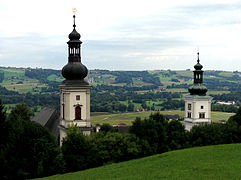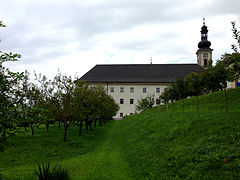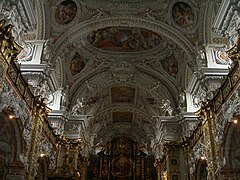
Trappist beer is brewed by Trappist monks. Thirteen Trappist monasteries—six in Belgium, two in the Netherlands, and one each in Austria, Italy, England, France, and Spain—currently produce beer, but the Authentic Trappist Product label is assigned by the International Trappist Association (ITA) to just ten breweries which meet their strict criteria. As of 2021, Achel is no longer recognized as a Trappist brewery because it does not have any living monks.

Heiligenkreuz Abbey is a Cistercian monastery in the village of Heiligenkreuz in the southern part of the Vienna woods, c. 13 km north-west of Baden in Lower Austria. It is the oldest continuously occupied Cistercian monastery in the world.

Zwettl Abbey is a Cistercian monastery located in Zwettl in Lower Austria, in the Diocese of St. Pölten.

Kremsmünster Abbey is a Benedictine monastery in Kremsmünster in Upper Austria.

Neuburg Abbey near Heidelberg in Baden-Württemberg is a Benedictine monastery dedicated to Saint Bartholomew, and part of the Beuronese Congregation.
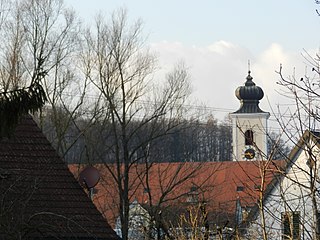
Gleink Abbey was a Benedictine monastery located in the town of Steyr in Austria.

Garsten Abbey is a former Benedictine monastery located in Garsten near Steyr in Upper Austria. Since 1851, the former monastery buildings have accommodated a prison.

Altenburg Abbey is a Benedictine monastery in Altenburg, Lower Austria. It is situated about 30 kilometres (19 mi) to the north of Krems an der Donau in the Waldviertel. It was founded in 1144,by Countess Hildeburg of Poigen-Rebgau. Throughout its history it suffered numerous invasions and attacks, and was destroyed by the Swedes in 1645. Under Emperor Joseph II in 1793 the abbey was forbidden to accept new novices, but unlike many others in Austria it succeeded in remaining functional.

Wilhering Abbey is a Cistercian monastery in Wilhering in Upper Austria, about 8 km (5 mi) from Linz. Stift Wilhering is the oldest Cistercian monastery in Upper Austria. The buildings, re-constructed in the 18th century, are known for their spectacular Rococo decoration.
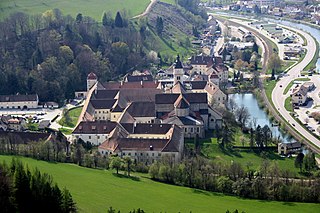
Lilienfeld Abbey is a Cistercian monastery in Lilienfeld in Lower Austria, south of Sankt Pölten.

Viktring Abbey is a former Cistercian monastery in the Austrian state of Carinthia. Stift Viktring is now the name of the Roman Catholic parish in Viktring, since 1973 a district of the Carinthian capital Klagenfurt.
Schlierbach is a municipality in the district of Kirchdorf an der Krems in the Austrian state of Upper Austria.

Rein Abbey is a Cistercian monastery in Rein near Gratwein, Styria, in Austria. Also known as the "Cradle of Styria", it is the oldest surviving Cistercian community in the world.
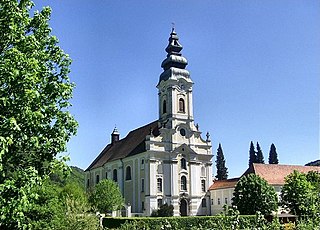
Engelszell Abbey was the last Trappist monastery, in Austria. It is located near Engelhartszell an der Donau in the Innviertel in Upper Austria.
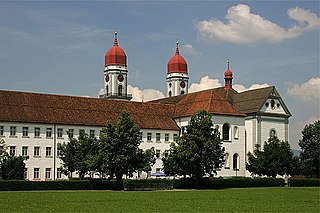
St. Urban's Abbey is a former Cistercian monastery in the municipality of Pfaffnau in the canton of Lucerne in Switzerland. It is a Swiss heritage site of national significance.

St. George's Abbey is a monastic complex in the village of Sankt Georgen am Längsee, Carinthia, Austria. It celebrated its 1,000th anniversary in 2003.

Pietro Francesco Carlone, or Peter Franz Carlone, from the Leoben branch of the Carlone family, was an early Baroque architect who was best known for building abbeys.

Reichersberg Abbey is a monastery of the Innviertel Congregation of the Austrian Augustinian Canons. It lies on the Inn River in Reichersberg, Upper Austria.





